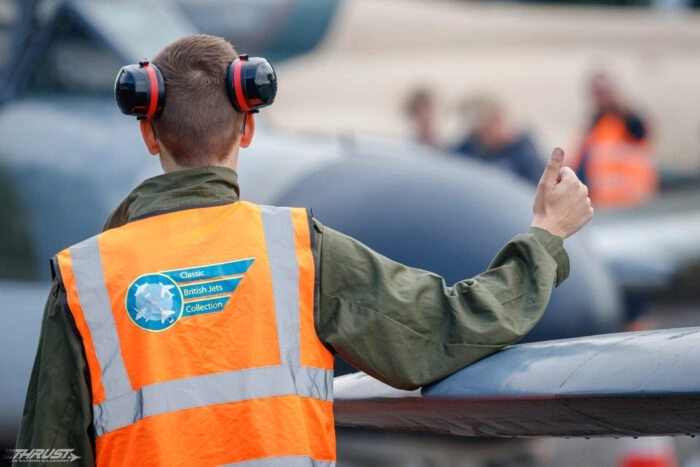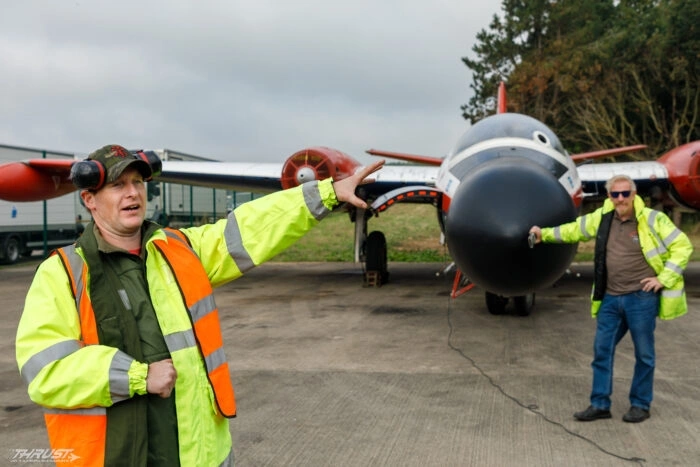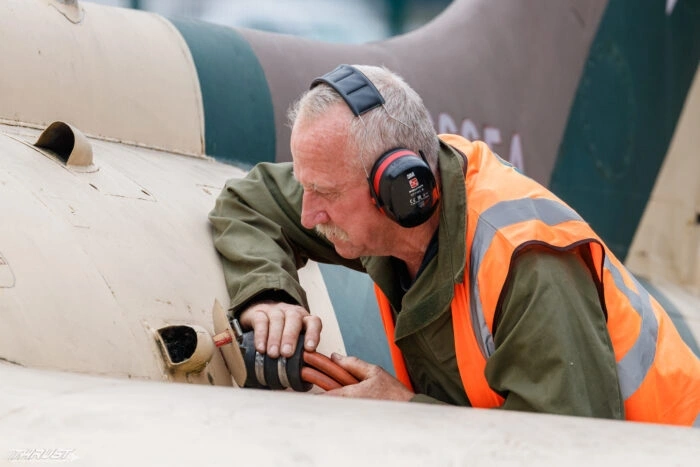Cold War Jets Open Day
Jul 01, 2024
By Bradley Rogers
On Saturday, 16th September, Bruntingthorpe Cold War Jets Collection once again opened its doors to the general public, for a day of close-quarters aviation action. A limited number of 150 tickets went on sale in advance, to those wanting to experience the smells, sounds and feelings of being up close to live and running vintage jets. The changes at Bruntingthorpe have been widely documented, which means access to the runway is no longer possible. However, the collection is lucky enough to have access to a large concrete apron located to the front of the QRA sheds and hardstanding land, which means the public can get closer than ever before to living and breathing vintage jets!
Space is probably the biggest challenge of organising any event at Bruntingthorpe in its current set up. Nevertheless, the teams are skilled in the logistics of moving around the aircraft, to allow for a smooth running order of the day. The open day consists of a fluid crowd line, after each run and systems demonstration, the aircraft simply have to be moved back into their allotted spaces, allowing for the next aircraft to take to the apron. A careful plan meant the teams had already lined up Canberra WT333 to kick things off, as this is the largest airframe currently on the allotted site. Then as the Canberra “Treble Three” team was setting up the Classic British Jets Collection began to arrange their aircraft, ready for the Canberra to be placed back into its spot. All a tricky operation on paper, but with experienced and skilled tug operators and ground crews, this was all a normal day at the office.

Above: The team carefully manoeuvring the aircraft, making room for the Canberra.

Above: Careful communication between the team is essential in a tight space.
The aircraft were of course taking centre stage, as with any Bruntingthorpe Open Day event, however, also on site to add to the day’s entertainment were the Leicester Modellers with their collection of aircraft models and Ukraine war dioramas. Wingless Wonders were also in attendance with their collection of cockpits available for talks and tours. As well as Merch stands, catering and of course the resident Lightning Preservation Group with their shop, hangar and three examples of English Electric Lightnings. There were plenty of things to keep everybody amused in between the aircraft engine runs and system demonstrations.
Before the start of the first aircraft run a short briefing was given, including some points of safety and the day’s running order. At this point it was also relayed to the public that in between each run they would need to clear the apron, either by moving into the Q-shed or around the back to where the various stands were located. This was in order to give the teams the maximum amount of room to manoeuvre the aircraft back into their slots and position the next aircraft. In handy fashion a vintage Air Raid Siren would sound, signalling five minute warning for the start of the next run and for everybody to get back into position.

Above: Collection member Steve giving the short briefing.
The aforementioned Canberra WT333, a modified B.6 and a former Royal Aircraft Establishment test aircraft, was already in position and first to kick things off. Powered by two Rolls-Royce Avon 109 engines, the start-up can be quite the spectacle. This is because this variant of Avon engine uses the famous cartridge start. This is not too dissimilar in looks to that of a spent artillery shell case, or large shotgun shell. This is screwed into the front of the engine and once fired performs similar to a rocket motor, burning fast, turning the starter and spooling up the engine ready for ignition. The exhaust from this start-up fires out at three points from the front of the intake, creating a rather spectacular three points of smoke. Once up and running the aircraft went through a series of system demonstrations, lowering the flaps, extending the air brakes, flickering the lights and exercising some of the controls. Then going through a series of power checks and tests, before coming back to idle and shutting down. Once happy and the aircraft was safe, the barriers were moved and public dispersed, the teams began moving the aircraft for the next run.

Above: Canberra WT333 cartridge start.

Above: Ground crew in constant communication talking the pilot through the various system demonstrations.
Next up was a former UK airshow regular with the Classic Air Force (formerly of Coventry Airport, Baginton), de Havilland Venom FB.50 WR470 (G-DHVM). Now forming part of the Classic British Jets Collection, and the wider Cold War Jets Collection, who took ownership of her back in 2018, following the demise of the Classic Air Force and vintage jets in general on the UK airshow circuit. The team stepped in to save her from almost inevitable scrapping and have endeavoured to keep the aircraft in live condition ever since. Once again, one of the interesting features of this aircraft is it retains the original 1950s cartridge start system. Working in a similar way to that of the Canberra, this time, firing upwards in a large singular plume, to start its de Havilland Ghost engine. A much smaller aircraft than that of the Canberra, allowed for a little closer-quarters action. Collection member Julian Warren was in the hot seat for this run. With the siren sounding and the public in position, the cartridge ignited, and the Ghost engine began to whine into life. Following similar fashion controls were exercised, flaps and air brakes lowered, finishing with a series of power checks. Much to the delight of the lucky ticket holders.

Above: Engine start, the cartridge fires spooling up the Ghost engine.
Next to take to the apron was another aircraft from the Classic British Jets Collection. This time showing off to the public was the magnificent Hawker Hunter GA.11 WT806 wearing the iconic Blue Herons display team scheme, which it once flew with. Once again, the sound of the air raid siren summoned the public back to the viewing area. This is another of the Avon engine powered aircraft, again using a cartridge to start, firing downwards immersing the aircraft in a cloud of dark smoke. In the hot seat was collection member Jordan Harding, who carefully brought the Hunter to life, exercising the systems and executing power checks, incredible to witness such close proximity.

Above: Hunter GA.11 in a cloud of smoke discharging from the cartridge start system.
Gloster Meteor NF.11 WM167, caused a little bit of a stir when the decision was made to ground the aircraft back in 2019. A deal by American businessman and aviation enthusiast Marty Tibbitts had seen him purchase the two Meteors that were formerly of the Classic Air Force based at Coventry Airport. This deal had already seen its sistership, Gloster Meteor T.7 WA591 (G-BWMF), depart for the states. Sadly, shortly after T.7’s departure, new owner Marty Tibbitts crashed and was killed in a de Havilland Venom as he was flying to the Planes of Fame airshow in 2018, which would also be the Meteor T.7’s public debut under Tibbitts’ ownership. The tragic set of circumstances threw the NF.11’s future up in the air. The decision was made to harvest the useful parts from the NF.11 as spares for T.7 out in the states. This put WM167 at risk of being scrapped. Luckily, Dave Thomas, head of the Classic British Jets Collection, stepped in to save the airframe. A ferry flight was initially looked at in order to fly the Meteor from its homebase at Coventry up to join the Bruntingthorpe Cold War Jets Collection, all of course before the subsequent changes had happened. On closer inspection, the aircraft was in such good condition the CAA in fact renewed its permit to fly for a further year. At the time it was hoped that someone may step forward and buy the aircraft to keep it flying, but as we all know, the classic jet seen in the UK is a tough business. Meteor NF.11 WM167 touched down at Bruntingthorpe for the final time on the 5th January 2019. As part of the deal to save the airframe the engines had to be removed. This left the NF.11 without engines for a while, however, the team at the Classic British Jets Collection managed to obtain a set of ground running Rolls-Royce Derwent engines, keeping WM167 in live condition ever since.
As a little bonus to the day the Collection held a raffle for a chance to win a seat in the back of the Meteor NF.11, during its run. The lucky winner climbed aboard with Dave Thomas at the controls. No cartridge starts this time, as the NF.11 is fitted with electronic starters. The aircraft wound up and began exercising the various controls, opening the air brakes, lowering the flaps and squeezing the power. A worthy prize to a great raffle!

Above: The raffle winner thanking the crews for his backseat experience.
Next, it was time for the Soviet contingent of the day’s running order. It couldn’t be a Cold War jets collection without some Soviet hardware, right? The L-29 forms part of a pair of former Soviet training aircraft that make up the collection. The other aircraft is an PZA TS-11 Iskra which was on static display for the day. Sadly, the L-29 Delfin was proving to be a stubborn old girl, and refusing to start. Much troubleshooting was tried, even connecting the aircraft to the GPU, but to no avail. It was time for the Grand Finale.

Above: Connecting the L-29 to the GPU, but the L-29 refuses to play ball. Back to the drawing board.
To finish the day in style both the Hunter GA.11 and de Havilland Venom, were brought back to the apron and placed side-by-side. Both having been refitted with their cartridges, the plan was to start both simultaneously. No easy feat. To ensure that both started at the right time a member of the crew would hold hands up and as they would drop, both would initiate their cartridge starts. It was timed to perfection, with the Hunter firing its smoky plume downwards and the Venom’s soaring skyward. Then, as they both came to life, both jets powered up together, creating plenty of noise, bringing the day’s proceedings to a remarkable close.

Above: Simultaneous start by the Hunter and Venom, timed to perfection.
Another successful open day was met with a warm reception by all. The team are constantly looking for new plans to bring the public back into the fold on the new museum site. However, like all things these jets do not run for free. So getting funds through the door is vital for their continued maintenance and preservation. It is hoped that in time some facilities can be established as well as extra space created to host the public on a regular basis, as a more dedicated museum site. The changes may have made things more difficult, but aviation at Bruntingthorpe is still very much alive!
Did you know our blogs are written exclusively by our members? We'd love for you to come and experience what COAP Online is all about!
Not yet a member?
Enjoy a free 30-day trial!
COAP Online membership brings 100s of aviation photographers from around the world together in a friendly, helpful and inspirational community. You'll enjoy monthly challenges, competitions, livestreams, blogs, exclusive discounts, meet-ups and more!




